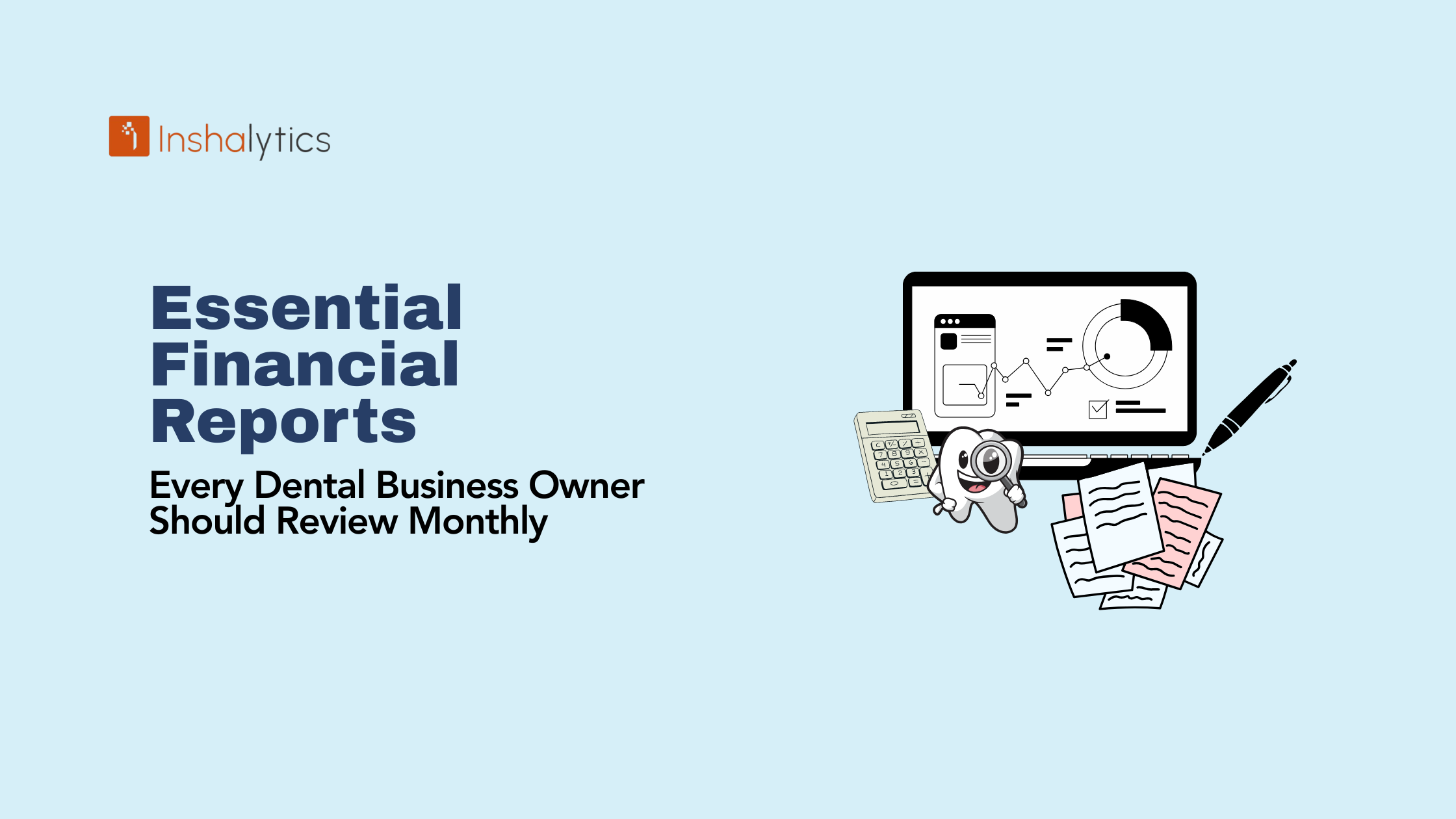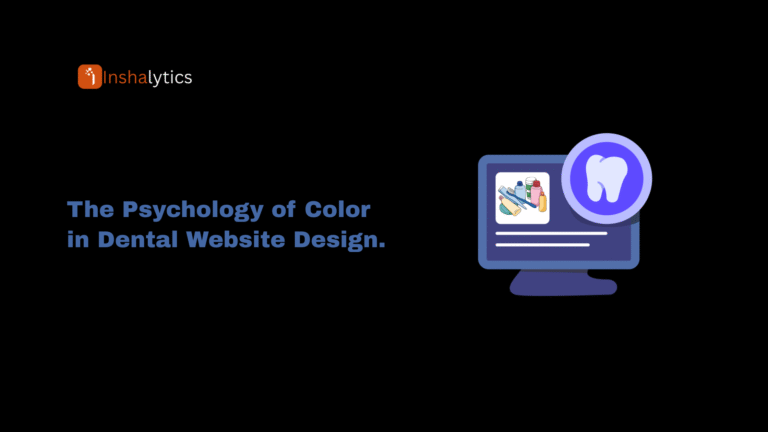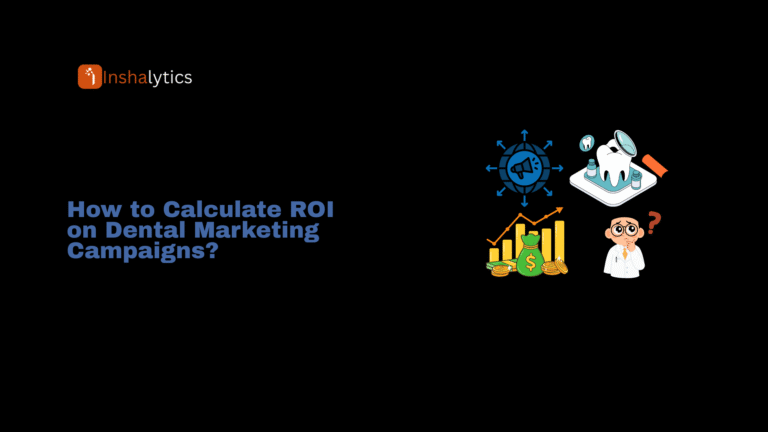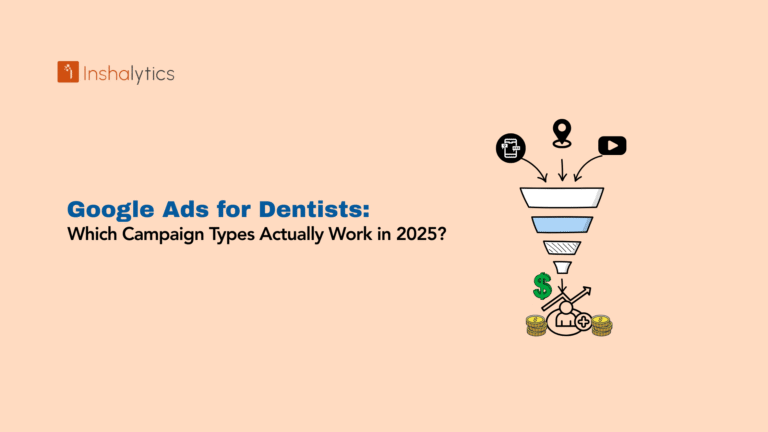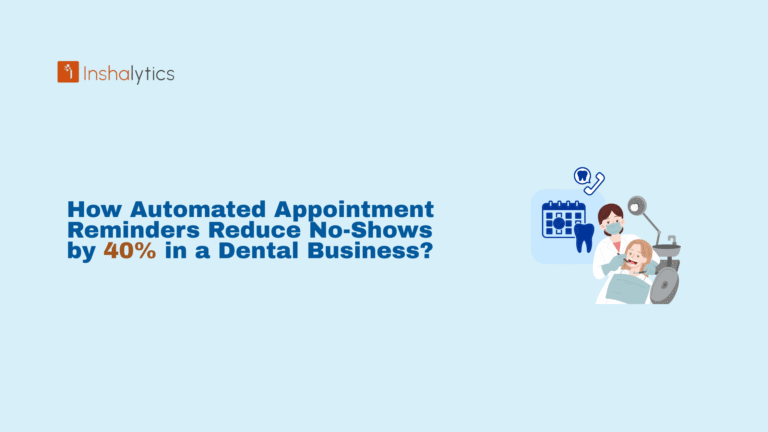Running a dental practice without regular financial oversight is like performing oral surgery blindfolded you might get lucky occasionally, but you’re setting yourself up for disaster. While you excel at providing exceptional patient care, the business side of dentistry requires the same level of precision and attention to detail that you bring to clinical procedures.
Dental practices face unique financial challenges that general businesses don’t encounter. From managing complex insurance reimbursements and patient financing to tracking production metrics and collection ratios, your practice operates in a highly regulated environment where cash flow can fluctuate dramatically based on seasonal patterns, insurance claim processing delays, and patient payment behaviors.
The Alarming Statistics: On average, dental practices lose approximately 9% of their production revenue due to uncollected revenues. Additionally, many dental practices struggle with overhead costs exceeding industry benchmarks, cash flow issues from delayed insurance payments, and inadequate financial visibility that prevents proactive decision-making.
That’s why reviewing dental practice financials on a consistent basis is crucial. Monthly financial reporting transforms these challenges into manageable insights. By reviewing your financial performance every 30 days instead of waiting for quarterly or annual reports, you can quickly identify revenue trends, spot collection problems before they impact cash flow, and make data-driven decisions about staffing, equipment purchases, and practice growth.
The Competitive Advantage: Dental practices that maintain consistent monthly financial reporting routines typically achieve collection rates of 98-99% (compared to the industry average of 91%), maintain overhead costs below the recommended 63% threshold, and demonstrate more stable cash flows that support strategic investments in technology and practice expansion.
The 3 Core Financial Reports Every Dental Practice Must Review Monthly
These foundational reports provide the essential framework for understanding your practice’s financial health and making informed business decisions that drive sustainable growth.
Profit & Loss Statement (Income Statement): Your Practice Profitability Dashboard
Your P&L statement is the heartbeat monitor for your dental practice, revealing not just whether you’re profitable, but how efficiently you’re converting patient treatments into revenue. Unlike general businesses, dental practices must track both production (services provided) and collections (payments received), creating a unique dynamic that requires careful analysis.
Dental-Specific P&L Components:
- Total Production: The full value of all dental services provided, regardless of payment timing
- Adjustments/Write-offs: Insurance contractual adjustments, patient discounts, and uncollectible accounts
- Net Production: Production minus adjustments (your true earning potential)
- Collections: Actual payments received from patients and insurance companies
- Cost of Goods Sold (COGS): Lab fees, dental supplies, and materials directly related to patient care
- Gross Profit: Collections minus COGS
- Operating Expenses: Staff salaries, rent, utilities, malpractice insurance, and marketing
- Net Income: Your bottom line after all expenses
Critical Dental Metrics to Calculate:
- Collection Percentage: Collections ÷ Net Production (Target: 98-99%)
- Overhead Percentage: Total Expenses ÷ Collections (Target: ≤63%)
- Production per Provider: Individual dentist and hygienist production tracking
- Production per Hour: Efficiency measurement for scheduling optimization
Monthly Analysis Focus: Compare current month performance against the same month in previous years to account for seasonal variations common in dental practices. Look for trends in case acceptance rates, average treatment values, and the mix between routine preventive care and higher-value restorative procedures. If your production is increasing but collections remain flat, investigate insurance processing delays or patient payment collection procedures.
Balance Sheet: Understanding Your Practice’s Financial Position
Your balance sheet provides a snapshot of everything your practice owns, owes, and your ownership equity at a specific point in time. For dental practices, this report is particularly important for tracking expensive equipment depreciation, managing debt from practice loans or equipment financing, and understanding your practice’s net worth for potential sale or expansion decisions.
Dental Practice Assets:
- Current Assets: Cash, patient receivables, insurance receivables, and inventory (supplies)
- Fixed Assets: Dental equipment, computers, furniture, leasehold improvements
- Intangible Assets: Practice goodwill, patient records value, and covenant not to compete
Dental Practice Liabilities:
- Current Liabilities: Accounts payable to suppliers, payroll taxes, and short-term loans
- Long-term Liabilities: Equipment loans, practice acquisition loans, and real estate mortgages
- Contingent Liabilities: Malpractice insurance deductibles, lease obligations
Owner’s Equity:
- Capital Contributions: Your initial and ongoing investments in the practice
- Retained Earnings: Cumulative profits reinvested in the practice
- Draws/Distributions: Money taken out of the practice for personal use
Key Dental Practice Ratios:
- Current Ratio: Current Assets ÷ Current Liabilities (Target: 1.5-2.0)
- Debt-to-Equity Ratio: Total Liabilities ÷ Owner’s Equity (Target: <1.0)
- Equipment Utilization: Production ÷ Equipment Value (efficiency measure)
Monthly Monitoring Points: Track changes in accounts receivable aging, as dental practices typically carry 45-60 days of receivables. Monitor equipment loan balances and depreciation schedules to plan for replacement cycles. Watch cash levels carefully, as dental practices often experience seasonal fluctuations and need adequate reserves for payroll, supplies, and unexpected equipment repairs.
Cash Flow Statement: Tracking the Lifeblood of Your Dental Practice
Cash flow management is particularly critical for dental practices due to the timing mismatch between providing services and receiving payments. Insurance companies may take 30-90 days to reimburse claims, while your staff expects weekly or bi-weekly paychecks and suppliers often require 30-day payment terms.
Operating Cash Flow (Primary Focus):
- Cash from Patient Payments: Direct payments, co-pays, and deductible collections
- Cash from Insurance: Reimbursements from dental insurance companies
- Cash Outflows: Payroll, rent, supplies, lab fees, and operating expenses
- Net Operating Cash Flow: The cash generated from core practice operations
Investing Cash Flow:
- Equipment Purchases: New dental technology, computers, and practice improvements
- Practice Improvements: Office renovations, technology upgrades
- Equipment Sales: Disposal of outdated equipment
Financing Cash Flow:
- Loan Proceeds: Equipment financing, practice loans, lines of credit
- Loan Payments: Principal and interest payments on existing debt
- Owner Draws: Money withdrawn by practice owners
Dental-Specific Cash Flow Metrics:
- Days Sales Outstanding (DSO): Average time to collect receivables (Target: 35-45 days)
- Cash Conversion Cycle: Time from service delivery to cash collection
- Insurance Claims Aging: Outstanding claims by 30/60/90+ day periods
Warning Signs to Monitor:
- Increasing accounts receivable with stable production (collection problems)
- Declining operating cash flow despite profitable P&L (timing issues)
- Growing dependence on lines of credit for operations (liquidity crisis)
- Lengthening the time between service delivery and payment collection
4 Additional Monthly Reports for Complete Dental Practice Visibility
These specialized reports address the unique operational and financial challenges specific to dental practices, providing deeper insights into areas that directly impact your bottom line.
Production and Collections Analysis Report
This report is the cornerstone of dental practice management, tracking the relationship between services provided (production) and payments received (collections). It’s unique to healthcare practices and essential for understanding your practice’s true financial performance.
Production Metrics to Track:
- Total Practice Production: Combined output of all providers
- Production per Provider: Individual dentist and hygienist performance
- Production per Hour: Efficiency measurement for scheduling optimization
- Production by Procedure Type: Identifying your most valuable services
- Case Acceptance Rate: Percentage of treatment plans accepted by patients
Collection Metrics to Monitor:
- Collection Percentage: Collections ÷ Net Production (industry benchmark: 91%, target: 98%+)
- Collection Timing: Average days from service to payment
- Payment Source Analysis: Insurance vs. patient payment ratios
- Write-off Analysis: Tracking adjustments and uncollectible accounts
Monthly Analysis Process: Calculate your collection percentage by dividing total collections by net production. If you’re consistently below 95%, investigate insurance claim processing procedures, patient payment policies, and accounts receivable management. Track production per provider to identify scheduling inefficiencies or training opportunities. Monitor case acceptance rates by provider to identify consultation and treatment planning improvement opportunities.
Optimization Strategies:
- Implement same-day scheduling for accepted treatment plans
- Offer multiple payment options, including financing
- Develop scripts for treatment plan presentations
- Create incentives for early payment or cash discounts
Accounts Receivable and Insurance Aging Report
This report tracks all outstanding payments owed to your practice, categorized by age and payment source. For dental practices, this is particularly critical due to complex insurance processing and varying patient payment behaviors.
Accounts Receivable Categories:
- Patient Receivables: Outstanding balances owed directly by patients
- Insurance Receivables: Pending reimbursements from insurance companies
- Secondary Insurance: Claims pending with secondary carriers
- Workers’ Compensation: Outstanding workers’ comp claims
Aging Analysis:
- 0-30 Days: Current, acceptable aging for insurance processing
- 31-60 Days: Requires follow-up but still within normal range
- 61-90 Days: Immediate attention needed, potential collection issues
- 90+ Days: High risk of becoming uncollectible
Key Performance Indicators:
- Total AR: Should not exceed 1.5-2 months of average production
- AR Turnover: How quickly you convert receivables to cash
- Bad Debt Percentage: Uncollectible accounts as a percentage of production
- Insurance vs. Patient AR Ratio: Balance of outstanding receivables
Monthly Management Actions: Review all accounts over 60 days and implement collection procedures. For insurance receivables, resubmit claims or contact carriers for status updates. For patient receivables, implement payment plan discussions or collection agency referrals. Track patterns by insurance carrier to identify consistently slow-paying plans that may require contract renegotiation.
Overhead Analysis and Expense Management Report
Dental practices typically aim for overhead costs at or below 63% of collections. This report breaks down your expenses into categories specific to dental practice operations, allowing you to identify areas for cost optimization without compromising patient care.
Staff Costs (Typically 25-30% of Collections):
- Clinical Staff: Dental hygienists, dental assistants, expanded function assistants
- Administrative Staff: Front desk, billing, practice coordinator
- Benefits and Payroll Taxes: Health insurance, retirement contributions, workers’ comp
- Continuing Education: Required CE for licensed staff members
Occupancy Costs (Typically 6-10% of Collections):
- Rent or Mortgage: Office space costs
- Utilities: Electric, gas, water, telecommunications
- Insurance: Property, liability, malpractice coverage
- Maintenance: Equipment service contracts, facility upkeep
Clinical Supplies and Lab Fees (Typically 6-8% of Collections):
- Dental Materials: Composites, impression materials, and anesthetics
- Laboratory Fees: Crowns, bridges, dentures, orthodontic appliances
- Disposable Supplies: Gloves, masks, sterilization pouches
- Equipment Maintenance: Service contracts, repairs, calibration
Marketing and Professional Costs (Typically 3-5% of Collections):
- Advertising: Digital marketing, print ads, referral programs
- Professional Services: Legal, accounting, consulting
- Professional Development: Conferences, training, memberships
- Technology: Software subscriptions, IT support, equipment leases
Monthly Benchmarking: Compare each expense category against industry benchmarks and your historical performance. Identify categories exceeding benchmarks and develop action plans for cost reduction. Look for opportunities to negotiate better terms with suppliers, optimize staffing schedules, or reduce unnecessary services.
Key Performance Indicators (KPI) Dashboard
This comprehensive dashboard tracks the vital signs of your dental practice, providing early warning indicators of potential problems and opportunities for growth optimization.
Production KPIs:
- Daily Production Goal: Target daily production to meet monthly/annual goals
- Provider Productivity: Production per hour for dentists and hygienists
- Treatment Mix: Percentage of preventive vs. restorative vs. cosmetic procedures
- Case Value: Average treatment plan value per patient
Patient KPIs:
- New Patient Acquisition: Monthly new patient count and growth rate
- Active Patient Count: Patients seen within the last 18 months
- Patient Retention Rate: Percentage of patients returning for continuing care
- Appointment Fill Rate: Percentage of available appointment slots filled
Financial KPIs:
- Collection Efficiency: Collections as a percentage of production
- Overhead Ratio: Total expenses as a percentage of collections
- Profit Margin: Net income as a percentage of collections
- Revenue per Patient: Average annual revenue per active patient
Operational KPIs:
- Schedule Utilization: Percentage of available appointment time filled
- Cancellation/No-Show Rate: Percentage of appointments not kept
- Treatment Acceptance Rate: Percentage of proposed treatment accepted
- Insurance Processing Time: Average days to receive insurance payments
Quality and Satisfaction KPIs:
- Patient Satisfaction Scores: Survey results and online reviews
- Referral Rate: New patients from existing patient referrals
- Recall Compliance: Percentage of patients maintaining recommended schedules
- Clinical Quality Metrics: Redo rates, complications, patient complaints
How to Create an Effective Monthly Dental Practice Reporting Process?
Establishing a systematic approach ensures consistent, accurate, and timely financial insights that drive informed decision-making and practice growth.
Setting Up Your Monthly Reporting Schedule for Dental Practices
Week 1 After Month-End (Days 1-7):
- Daily Deposit Reconciliation: Verify all patient payments and insurance checks are properly recorded
- Insurance Claim Status Review: Check on pending claims and resubmit as needed
- Accounts Receivable Aging: Update patient payment status and insurance processing
- Supply Inventory Count: Physical count of dental supplies and materials
- Payroll and Benefits Reconciliation: Ensure all staff costs are properly recorded
Week 2 (Days 8-14):
- Production Report Generation: Compile monthly production by provider and procedure type
- Collection Analysis: Calculate collection percentages and identify outstanding receivables
- Expense Categorization: Review and properly code all business expenses
- Lab Fee Reconciliation: Match lab work to invoices and patient treatments
- Equipment Maintenance Review: Document service costs and schedule upcoming maintenance
Week 3 (Days 15-21):
- Financial Statement Preparation: Generate P&L, balance sheet, and cash flow reports
- KPI Dashboard Update: Calculate key performance indicators and update tracking
- Variance Analysis: Compare actual results to budget and previous periods
- Patient Analysis: Review new patient counts, retention rates, and treatment acceptance
- Insurance Contract Review: Analyze reimbursement rates and identify problematic carriers
Week 4 (Days 22-28):
- Final Report Review: Verify the accuracy of all financial statements and reports
- Management Meeting Preparation: Create summary presentations for practice review
- Action Plan Development: Identify areas needing improvement and create specific action items
- Budget Updates: Adjust forecasts and budgets based on actual performance
- Next Month Planning: Set goals and priorities for the upcoming month
Essential Software and Tools for Dental Practice Financial Reporting
Practice Management Software Integration:
- Dentrix: Comprehensive practice management with robust reporting capabilities
- Eaglesoft: Strong financial reporting and patient management features
- Open Dental: Cost-effective solution with customizable reporting options
- Curve Dental: Cloud-based system with real-time financial dashboards
Accounting Software Options:
- QuickBooks: Most popular choice for dental practices, with dental-specific add-ons
- Xero: Cloud-based accounting with strong integration capabilities
- Sage: Advanced features for multi-location practices
- FreshBooks: Simple solution for smaller practices
Specialized Dental Analytics Tools:
- Dental Intelligence: Advanced analytics and automated reporting for dental practices
- Practice by Numbers: Comprehensive dental practice analytics and benchmarking
- Sikka Software: Dental practice management and analytics platform
- RevenueWell: Patient communication and practice analytics combined
Key Integration Features to Prioritize:
- Automated Data Transfer: Eliminate manual data entry between systems
- Real-time Reporting: Access to current financial information at any time
- Customizable Dashboards: Tailor reports to your specific practice needs
- Mobile Access: View reports and make decisions from anywhere
- Automated Alerts: Notifications for critical KPIs falling below thresholds
What to Look for When Analyzing Your Dental Practice Reports?
Production Analysis:
- Seasonal Patterns: Identify recurring trends in treatment patterns and patient flow
- Provider Performance: Compare individual dentists and hygienists’ productivity
- Treatment Mix Evolution: Track shifts from preventive to restorative procedures
- Scheduling Efficiency: Analyze appointment utilization and time management
Collection Trends:
- Payment Source Shifts: Monitor changes in insurance vs. patient payment ratios
- Collection Timing: Identify trends in days’ sales outstanding
- Write-off Patterns: Track increases in contractual adjustments or bad debt
- Payment Method Preferences: Analyze cash, credit, and financing utilization
Expense Management:
- Cost Per Patient: Calculate treatment costs relative to patient volume
- Supplier Performance: Monitor lab fees, supply costs, and vendor reliability
- Staff Productivity: Analyze labor costs relative to production levels
- Technology ROI: Measure return on investment for equipment and software
Patient Metrics:
- Acquisition Costs: Track marketing spend per new patient acquired
- Lifetime Value: Calculate long-term revenue potential per patient
- Retention Patterns: Identify factors influencing patient loyalty
- Treatment Acceptance: Analyze consultation effectiveness and pricing sensitivity
Using Your Dental Practice Financial Reports to Drive Strategic Decisions
Transform your financial data into actionable strategies that improve patient care, increase profitability, and position your practice for sustainable growth.
Identifying Trends and Red Flags in Dental Practice Finances
Production Warning Signs:
- Declining case acceptance rates may indicate pricing issues, insurance coverage changes, or consultation skill problems
- Decreasing production per hour suggests scheduling inefficiencies or provider productivity concerns
- Shift toward lower-value procedures might reflect patient economic pressures or lack of treatment plan diversity
Collection Red Flags:
- Increasing accounts receivable aging signals collection procedure problems or staff training needs
- Declining collection percentages indicate insurance processing issues or patient payment collection problems
- Growing write-off percentages may suggest fee schedule misalignment with insurance contracts
Cash Flow Danger Signals:
- Increasing dependence on credit lines for operational expenses
- Lengthening payment cycles from insurance companies
- Declining cash reserves despite profitable operations
- Seasonal cash flow extremes that impact operational stability
Overhead Escalation Indicators:
- Staff costs exceeding 30% of collections without corresponding productivity increases
- Supply costs are creeping above 8% due to inflation or waste
- Facility costs are increasing without practice growth to support them
- Technology costs are accumulating without demonstrable ROI
Making Data-Driven Growth Decisions for Your Dental Practice
Capacity Optimization: Use production per hour metrics to optimize scheduling and identify opportunities for additional appointment slots. If your hygienists are consistently booked while dentist schedules have gaps, consider adding prevention-focused services or adjusting the hygienist-to-dentist ratio.
Service Line Development: Analyze your treatment mix to identify underperformed but profitable services. If cosmetic dentistry shows high margins but low volume, invest in marketing and staff training to expand this revenue stream. Consider adding services like sleep apnea treatment or orthodontics if patient demographics support demand.
Pricing Strategy Refinement: Compare your fees to local market rates and insurance reimbursement schedules. If collection percentages are high but production growth is stagnant, you may have room for selective fee increases. Focus increases on high-demand services where patients show strong acceptance rates.
Technology Investment Analysis: Use ROI calculations to evaluate equipment purchases. Digital impression systems may reduce lab costs and improve patient experience, while CBCT machines might attract referrals and enable additional services. Calculate payback periods based on increased efficiency and revenue potential.
Staffing Decisions: Analyze production per provider to determine optimal staffing levels. If a hygienist consistently produces 3-4 times their salary cost, adding another hygienist position may be profitable. Consider expanded function dental assistants if your state allows delegation of certain procedures.
Strategic Planning Based on Financial Performance
Practice Expansion Evaluation: Use cash flow projections and debt capacity analysis to assess expansion opportunities. Consider factors like local market demographics, competition analysis, and your ability to maintain quality while scaling operations.
Associate Integration Planning: Calculate break-even production levels for potential associates based on your overhead structure and compensation plans. Factor in patient transfer rates and the time needed to build associate schedules to full capacity.
Equipment Replacement Strategies: Develop replacement schedules based on equipment age, maintenance costs, and technology advancement. Plan major purchases to optimize tax benefits and cash flow impact while ensuring clinical capabilities remain competitive.
Insurance Contract Negotiations: Use collection data and patient demographics to evaluate insurance contract profitability. Consider terminating contracts with consistently low reimbursement rates if patient volume doesn’t justify the administrative burden.
When Dental Practice Owners Should Seek Professional Help?
Consider Professional Assistance When:
- Collection percentages consistently fall below 95% despite internal improvement efforts
- Overhead costs exceed 65% without clear cost reduction strategies
- Cash flow issues persist despite profitable operations
- Financial reports show conflicting information or inconsistencies
- You’re considering major practice changes like expansion, sale, or associate partnership
Types of Professional Support:
Dental Practice Consultants:
- Specialized expertise in dental practice operations and financial management
- Industry benchmarking and performance optimization
- Staff training for collection procedures and patient communication
- Practice transition planning and valuation services
Dental CPAs and Accountants:
- Tax planning strategies specific to dental practices
- Financial statement preparation and analysis
- Practice valuation for buy/sell decisions
- Retirement and succession planning
Dental Practice Management Companies:
- Comprehensive practice operations oversight
- Advanced analytics and reporting capabilities
- Staff training and development programs
- Marketing and patient acquisition strategies
Healthcare Attorneys:
- Practice sale and acquisition transactions
- Employment agreement negotiations
- Insurance contract review and negotiation
- Regulatory compliance issues
Selecting the Right Professional Support: Look for professionals with extensive dental practice experience who understand the unique challenges of your industry. Verify their credentials, request references from similar practices, and ensure they use technology compatible with your practice management systems. Consider professionals who offer integrated services to minimize coordination complexity.
Take Control of Your Dental Practice Finances Starting This Month
Monthly financial reporting isn’t just about tracking numbers it’s about transforming data into decisions that enhance patient care, improve practice profitability, and build long-term practice value. The most successful dental practice owners are those who embrace their role as healthcare business leaders, using financial insights to create sustainable, thriving practices.
Your Immediate Action Plan:
Week 1 – Assessment:
- Audit Your Current Reporting: Review what financial reports you currently receive and identify gaps
- Benchmark Your Performance: Calculate your collection percentage, overhead ratio, and production per provider
- Identify Problem Areas: Look for patterns in accounts receivable aging or declining productivity trends
Week 2 – System Setup:
- Optimize Your Practice Management Software: Ensure all reporting features are activated and properly configured
- Establish Reporting Calendar: Create monthly deadlines for each reporting component
- Train Your Team: Educate staff on the importance of accurate data entry and reporting procedures
Week 3 – Implementation:
- Create Your KPI Dashboard: Select 8-10 key metrics most relevant to your practice goals
- Develop Analysis Templates: Create standardized formats for monthly report review
- Set Performance Targets: Establish realistic but challenging goals for key metrics
Week 4 – Action:
- Schedule Monthly Reviews: Block calendar time for consistent financial analysis
- Identify Quick Wins: Implement immediate improvements based on current data
- Plan Long-term Strategies: Use insights to develop 6-12 month practice improvement plans
Remember the Fundamentals:
- Consistency Over Perfection: Regular, good reporting beats perfect, sporadic reporting
- Action-Oriented Analysis: Every report should lead to specific, actionable insights
- Patient-Centered Financial Management: Financial health enables better patient care, not the opposite
- Continuous Improvement: Use monthly reporting to make incremental improvements that compound over time
The Long-term Vision: Practices that implement comprehensive monthly financial reporting typically see:
- 5-8% improvement in collection percentages within the first year
- 10-15% reduction in overhead costs through better expense management
- 20-30% improvement in cash flow predictability, enabling strategic investments
- Significantly higher practice values when considering sale or transition
Your dental practice represents years of education, training, and dedication to improving patients’ oral health. Don’t let inadequate financial management undermine everything you’ve worked to build. Starting this month, commit to the same level of precision and attention to detail in your business management that you bring to patient care.
The practices that thrive in today’s competitive healthcare environment are those that master both clinical excellence and business acumen. By implementing these monthly financial reporting practices, you’re not just improving your bottom line you’re building a sustainable foundation for delivering exceptional patient care for years to come.
Bottom Line: Monthly financial reporting transforms reactive practice management into a proactive business strategy. When you understand your numbers at this level of detail, you gain the confidence and capability to make decisions that simultaneously improve patient outcomes and practice profitability. Start this month, be consistent, and watch your practice reach new levels of success and sustainability.
